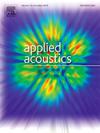Effects of the frequency filter type of measurement equipment on evaluation of floor impact sound insulation
IF 3.4
2区 物理与天体物理
Q1 ACOUSTICS
引用次数: 0
Abstract
This study examines the influence of frequency filters on the evaluation of floor impact sound insulation by comparing the performances of Butterworth and FFT-based filters. Experimental data were collected from 15 residential units with identical floor plans to reflect on-site conditions. The findings reveal that even when the filters comply with IEC 61260-1 Class 1 standards, performance differences exist depending on the type of impact source and evaluation method. For light-weight impact sounds, which are assessed using time-averaging equivalent continuous sound levels, the 12th-order or higher Butterworth filters provided results comparable to those of the FFT-based filter. For heavy-weight impact sounds, which are evaluated using fast time-weighting followed by the maximum sound level, the FFT-based filter showed distinct characteristics, including higher frequency resolution and independence from stabilization time. These features suggest that FFT-based filters may offer advantages in postprocessing over traditional Butterworth filters. This study underscores the importance of understanding filter performance variations in impact sound insulation for regulatory compliance and calls for further investigation of filter selection in practical applications.
频率滤波型测量设备对地板冲击隔声评价的影响
本研究通过比较巴特沃斯滤波器和fft滤波器的性能,探讨频率滤波器对地板隔声效果评价的影响。实验数据来自15个具有相同平面图的住宅单元,以反映现场情况。研究结果表明,即使过滤器符合IEC 61260-1类标准,根据影响源的类型和评估方法的不同,性能差异也存在。对于使用时间平均等效连续声级评估的轻量级冲击声音,12阶或更高的巴特沃斯滤波器提供的结果与基于fft的滤波器相当。对于使用快速时间加权和最大声级来评估的重型撞击声,基于fft的滤波器表现出明显的特性,包括更高的频率分辨率和与稳定时间无关。这些特征表明,基于fft的滤波器在后处理方面可能比传统的巴特沃斯滤波器更有优势。这项研究强调了了解过滤器性能变化对法规遵从性的重要性,并呼吁在实际应用中进一步研究过滤器的选择。
本文章由计算机程序翻译,如有差异,请以英文原文为准。
求助全文
约1分钟内获得全文
求助全文
来源期刊

Applied Acoustics
物理-声学
CiteScore
7.40
自引率
11.80%
发文量
618
审稿时长
7.5 months
期刊介绍:
Since its launch in 1968, Applied Acoustics has been publishing high quality research papers providing state-of-the-art coverage of research findings for engineers and scientists involved in applications of acoustics in the widest sense.
Applied Acoustics looks not only at recent developments in the understanding of acoustics but also at ways of exploiting that understanding. The Journal aims to encourage the exchange of practical experience through publication and in so doing creates a fund of technological information that can be used for solving related problems. The presentation of information in graphical or tabular form is especially encouraged. If a report of a mathematical development is a necessary part of a paper it is important to ensure that it is there only as an integral part of a practical solution to a problem and is supported by data. Applied Acoustics encourages the exchange of practical experience in the following ways: • Complete Papers • Short Technical Notes • Review Articles; and thereby provides a wealth of technological information that can be used to solve related problems.
Manuscripts that address all fields of applications of acoustics ranging from medicine and NDT to the environment and buildings are welcome.
 求助内容:
求助内容: 应助结果提醒方式:
应助结果提醒方式:


